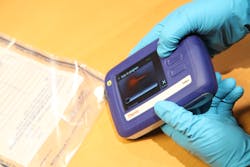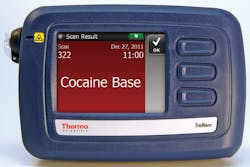Technology for the Safety of First Responders
More than 72,000 people died of drug overdoses in the U.S in 2017, according to the Centers for Disease Control and Prevention. This was a 9.5% increase from 2016, and many point to the abuse of fentanyl and other synthetic opioids as the reason. In fact, in August 2018, the Massachusetts Department of Public Health reported that the presence of fentanyl in the toxicology of those who died from opioid related deaths in that state rose to nearly 90% in 2018.
Fentanyl is now a fixture in the illegal drug market, and it’s primarily being smuggled into the U.S. from Mexico and China. In what is believed to be the largest seizure in pill form, U.S. Customs and Border Protection (CBP) officers in San Diego seized 20,000 fentanyl pills along the U.S.-Mexico border in August last year. Also in August, law enforcement seized 110 pounds of fentanyl in Philadelphia’s port hidden in a shipment of iron oxide originating from China. President Trump recently call opioids coming into the U.S. from Mexico and China “almost a form of warfare.”
The dangers of fentanyl to drug users are well known. Now, that same worry goes beyond users to law enforcement officials whose work puts them dangerously close to a substance that the U.S. Drug Enforcement Agency estimates is 50 times more potent than heroin and 80-100 times more potent than morphine.
Drugs like fentanyl are especially dangerous because they can be absorbed through the skin or mouth. Last August, in Pennsylvania, 29 employees from 10 state prisons were hospitalized from exposure to a “bad batch” of street drugs, presumably laced with fentanyl, that were mailed to or smuggled into the prisons. Around the same time, seven drug officers, serving a search warrant in Hartford, Conn., were exposed to what was believed to be airborne fentanyl. They reported feeling nauseated and light-headed.
Identification and protection
Technology used to remove deadly drugs from the street can also provide life-saving protection to law enforcement. This line of thinking is important, especially now, because it serves as an important reminder of the need to handle these newer drugs with greater care. Fortunately, new technology, funded through recent legislative action, is making it possible to be both tenacious and safe.
Massachusetts Senator Edward Markey spearheaded the passage of legislation to stop the flow of fentanyl into the U.S. The International Narcotics Trafficking Emergency Response by Detecting Incoming Contraband with Technology (INTERDICT) Act, which was signed into law in January 2018, provides CBP with critical funding to deploy tools such as chemical screening devices that help identify and interdict fentanyl and similar opioids.
At its International Mail Facilities (IMFs), which receive mails arriving from more than 180 countries, CBP officers rely on solutions such as the Thermo Scientific TruNarc handheld analyzer, which uses Raman spectroscopy to identify suspicious substances. When fentanyl is identified, controlled deliveries can be executed without harming officers.
Impact on law enforcement and communities
The good news is that the TruNarc analyzer has enabled CBP to increase fentanyl seizures dramatically without compromising officers’ safety. According to CBP data, its Office of Field Operations seized 1,304 pounds of fentanyl during the first three quarters of fiscal year 2018 (October 1, 2017 to June 30, 2018). During that same period in 2016, that figure was just 440 pounds.
CBP can now handle greater volumes more efficiently without putting officers in danger. This sets a bar for all of law enforcement, all the way from the state level to the local level. Better technology and processes can indeed keep dangerous drugs out of the wrong hands, and, literally, out of the exposed hands of law enforcement officers.
Getting synthetic opioids identified and off the streets is a national priority. Thanks to efforts made by CBP, many local and state level law enforcement agencies and other first responders, there is a path forward, and legislation such as the INTERDICT Act is helping shine a light on the problem as well as the need to safeguard officers. Getting drugs off the streets without putting law enforcement officers at greater risk is the most important goal, and technology can play a pivotal role moving forward.
Law enforcement casualties must not be a consequence of waging a war on opioids. Any tools and processes that can help avoid loss of life and livelihood are certainly no luxuries.
About the Author

Ginger Xu
Product Manager at Thermo Fisher Scientific
Ginger Xu is a Product Manager at Thermo Fisher Scientific in Massachusetts with nearly 20 years of experience in Product Development, Project Management, Marketing, and Operations in various industries. Ginger has a Master of International Management degree from Whitworth University. She is also a certified Project Management Professional (PMP) and the author of two books that were published in China.


